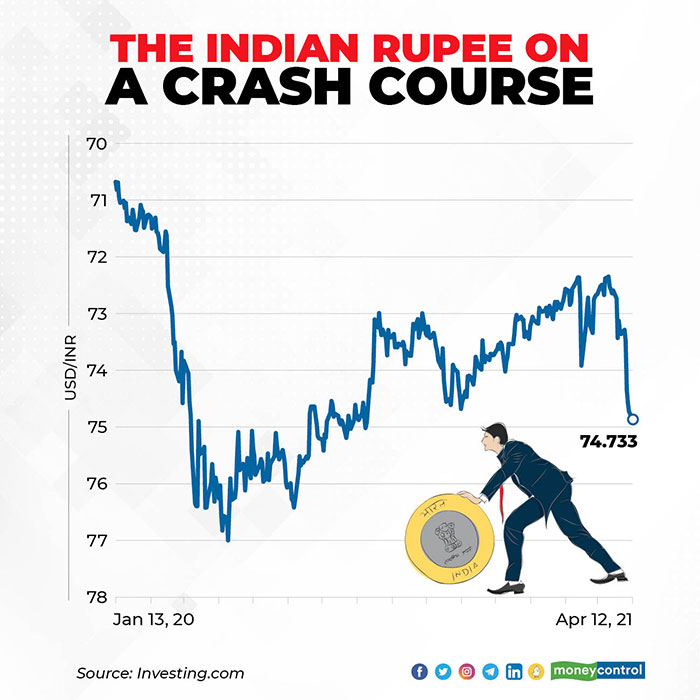
Representational image: Shutterstock
The Indian Rupee plunged below 75 against the US dollar on Monday to an eight-month low, while the benchmark equity index, Sensex, lost 1700 points. The Rupee later recovered from the intra-day low but still trading lower by 15 paise at 74.89 per dollar. It has fallen over 2 percent on a year-to-date basis. Here’s a short explainer on what could be the possible reasons that’s troubling the Rupee.
What’s ailing the Rupee? There are couple of factors.
A resurgence of COVID-19 is spreading panic across markets. Rupee is tracking the weakness of the broader markets. Sensex and Nifty crashed on Monday fearing increased restrictions in the wake of the rising number of cases. Maharashtra, home to India’s financial capital Mumbai, has recorded a significant spike in fresh cases in recent days, which has sparked fears of a lockdown. The state government has indicated that it will have to impose a lockdown in the state if the cases increase beyond a point. A lockdown will impact businesses and affect all segments of the economy. That possibility is hurting the markets and the Rupee.

What are the other reasons hurting the currency?
There are macro-economic reasons as well. A lower interest-rate regime is hurting the Rupee. The Reserve Bank of India (RBI), in a bid to support the Government borrowing, has announced massive bond purchases. Under G-SAP 1.0, the RBI will purchase Rs 1 lakh crore worth bonds from the market. It wants to keep the G-Sec yield at 6 percent of below. The first phase of bond purchase will be on April 15. This means, the system will be flooded with excess liquidity. Already, banks are parking money in RBI’s reverse repo basket. There is excess liquidity of Rs7 lakh crore in the banking system. With the RBI’s bond buy plan, the system will get a fresh infusion of liquidity.
So, what if liquidity increases?
If Rupee liquidity goes up in the market, that puts pressure on the value of the Rupee. A strengthening dollar will add to this weakness. The value of Rupee against the dollar will erode as supply of the local unit increases. Also, by injecting abundant liquidity in the banking system, the RBI is signalling that interest rates will remain low for a long time. Moreover, the RBI has explicitly stated that the rate-setting panel will maintain an ‘accommodative’ stance as long as necessary to support growth. This means the monetary policy committee (MPC) is in no mood to hike key policy rates even if inflation is inching up. Because growth is the priority now.
But how will low interest rates impact Rupee?
Low interest rates will prompt big investors to pull back capital from India to home markets where rates are actually hardening. India will no longer be an attractive market. When capital is pulled out, it will hurt the local unit.
“We have already seen FPI for the month being marginally negative so far at – $ 131 mn. The trade deficit has been widening and will continue to do so as the economy recovers, and imports pick up. Global commodity prices are rising which will widen the deficit. Exports need to pick up, but one cannot be sure. Therefore, the fundamentals will tend to point towards depreciation. The RBI promise of ample liquidity has hastened this process,” the rating agency CARE said in a note today.
What is the RBI’s stance?
According to traders and economists, the central bank is “okay” to let the Rupee depreciate because it cannot support both bonds and Rupee at the same time. The RBI’s preference is to keep the bond yields down in a range to lower the borrowing cost of the Government. The Government plans to borrow a massive Rs12 lakh crore this year to support its expenditure plans. If the Rupee is depreciating in a gradual manner, the central bank may not intervene immediately. It will, if the currency movement becomes more volatile.
Where is the Rupee headed?
It is hard to predict but the Rupee may be heading to 76-levels, according to some traders. The RBI’s G-SAP plan impact on the markets needs to be watched closely. And after the first open market purchase this month, there will be some clarity on the course of the currency. For now, the trend indicates general weakness in the currency.
